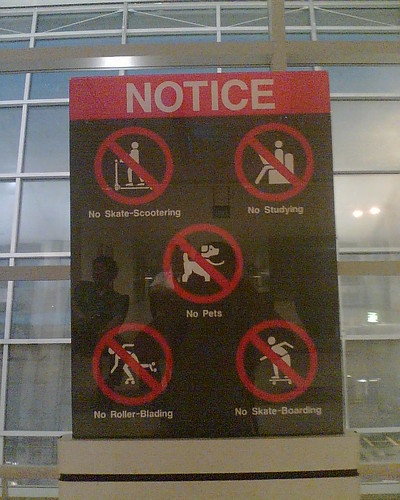The smug little banner
Pity
the poor banner. Maligned by millions and attacked by the very people whose
paychecks they (largely) make possible, the banner is perhaps the most
criticized little workhorse in our culture.
But
do banners let our harsh words affect their self esteem? No. Banners proudly
hold their ground -- shrinking for no one. They know that other people's
opinions of them are none of their business. They know that, like the periplaneta americana they will be here long
after their detractors have returned to ashes and dust. Perhaps with little
smirks on their faces as their last attackers return to the earth.

Why
can the little banner rest easy knowing that it will get the last eight-second
(max) laugh? Because no matter how much we poseurs pretend to despise them,
they serve a critical purpose in the internet environment -- and will continue
to do so for the foreseeable future.
Why
can these quietly smug little messages be so certain that their future is
bright? Let's take a look at five reasons.
1. Effectiveness
Banners work -- hard, in fact
People
wax philosophic about banner blindness. They point to remarkably small click
rates and studies that suggest that large numbers of people don't interact with
them.

Photo: Irina Slutsky
But
empirical evidence proves that they work plenty hard. There are lots of studies
that demonstrate their efficacy. I'll confine this discussion to just one. The
IAB did a study several years ago that demonstrated a broad range of positive
impacts from banner ads. Fielded across 12 leading websites with 16,758 respondents, the study
demonstrated significantly strong impacts on awareness, brand measures, and
purchase.
Further, the in-market experience
of thousands -- hundreds of thousands of advertisers -- also proves their
effectiveness. Digital is arguably the most accountable media available. And
every year, more companies spend more money on banners. Why? Because they deliver
against concrete business objectives. The results and reporting show this over
and over again.
Banners work well despite serving
in an environment with remarkable clutter. It's not at all unusual for there to
be 12 banners on a page -- pages they might also share with video players,
articles, and other forms of content. Despite this plethora of distractions,
banners continue to deliver cost effective means to drive sales, awareness, and
brand perceptions. Would they work better in a less
cluttered page? Probably. But they do their jobs even in environments filled
with myriad distractions.
2. Necessary evils
They're like death and taxes -- inevitable
Not
every ad can explode on a screen in expanderiffic intrusiveness. Multiple
interstitials between every page wouldn't make for much of a consumer
experience. If you accept that it is unrealistic to expect consumers to seek
out all of the marketing experiences necessary to keep the economy going -- if
you accept that we need loads of revenue to keep the lights on at content sites
-- then ads on pages are going to be part of the web experience for years to
come.
Am
I suggesting that they are better than rich, involving, multimedia experiences that consumers actively seek? For some brands, yes. Not every communication
challenge requires depth. And most brands cannot afford to do everything with
bells and whistles.

Photo: BBT609
Banners
are limited in their ability to communicate complicated stories. But for many
companies and brands, they are the most cost-effective means of delivering a
graphical message. Publishers will continue to leverage them as a means of
monetizing pages in lieu of spawning foreground experiences every time the user
moves a mouse over text or a photo or another page element.
Hey,
if you are a brand that can afford to do everything rich and big and bold,
fantastic. Knock yourself out. But in order to monetize the hundreds of
millions of pages of content out there, we need a standardized, simple-to-execute
solution that doesn't totally tick consumers off.
3. Revenue and technology advances
They are marvelous foot soldiers in the
battle for revenue
Banners
deliver great results in direct response programs, which continue to comprise
fully half of digital advertising. While the click and interaction rates for
banners have always been rather low, so too are their typical prices.

Premium
publications can command high CPMs precisely because banners on their sites
deliver results that warrant these costs. But the even bigger story is that the
vast majority of banners sell for remarkably low CPMs. These low rates more
than make up for the small response rates they spawn. Further, when the
view-through impacts are computed, the value per dollar spent on banners is
even more apparent.
Finally,
the advent of affordable attribution analyses is demonstrating that banners are
even more powerful components of direct-response programs, helping to drive far
more sales than can be directly attributed to them through click-through
analysis.
They just keep getting smarter
Minimally
targeted dirt cheap tonnage will probably play an important role for lots of
brands for the foreseeable future. But the explosion in available targeting
data, coupled with exchange-based purchasing platforms for these targeting
aids, has transformed the banner business into a world in which highly refined
messages can be delivered to specific audience segments cost effectively and
with minimal waste.

Photo: Geoff Stearns
That's
a key way banners have gotten smarter on the back end. On the front end, new
technologies have dramatically expanded the range of capabilities and
interactions possible within the confines of these small commercial spaces.
Video, dynamic content, multiple hotspots, and more -- these elements all drive
more and different interactions amid declining third-party technology costs.
5. A sound business model
It doesn't matter that people don't like
them
You'd
be hard pressed to find a consumer who looked forward to seeing more banners as
he or she surfed the web. But when push comes to shove, consumer preference
doesn't matter much here. Banners are providing a huge portion of the revenue
for content creators online. And a decent web designer can create templates and
pages where banners have noticing value but don't drive viewers off.

Photo: caizhonghan
Hey,
someone has to pay for all this content and access, and banners appear to be a
way to balance the need for revenue with consumers' reluctance to pay for
content. People understand the need for ads and revenue. While they may not
relish the experience of seeing these ads, they understand that, without them,
a lot of the content they enjoy would disappear.
No comments:
Post a Comment
Because people have been abusing the comment platform to place phony links to deceptive sites, I am now moderating all comments. If your comment is legit and contains a relevant link, it will be published.